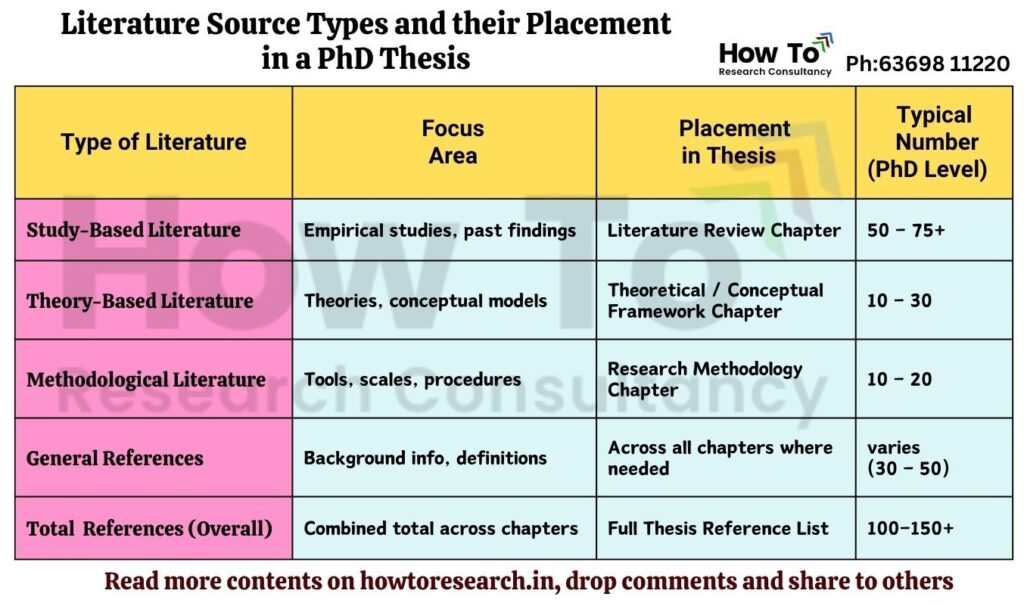A literature review is not merely a summary of existing studies. It is a critical synthesis that maps out what is known, what is debated, and what is yet to be explored in a particular field of research. A well-structured literature review is the foundation of any high-quality academic work, whether it be a research paper, dissertation, thesis, or grant proposal.
In this blog, we will walk through a step-by-step guide to conducting a literature review, enriched with practical examples from different academic domains—such as marketing, psychology, environmental science, and information technology.
Step 1: Define the Scope and Objectives
Before diving into databases and reading articles, clarify:
- What is the focus of your research?
- What specific questions do you want to answer?
- What are your key variables or constructs?
Example – Psychology
If you’re exploring the impact of mindfulness on academic stress among college students, your scope is narrowed to mental health, stress, and mindfulness practices in higher education settings.
Objective: To understand how mindfulness interventions reduce stress among undergraduate students.
Step 2: Search for Relevant Literature
Use academic databases like Google Scholar, Scopus, PubMed, JSTOR, ScienceDirect, Web of Science, and others. Use Boolean operators (AND, OR, NOT) to filter search results.
Example – Marketing
Suppose you’re studying “The Influence of Social Media Marketing on Brand Loyalty.” Use search terms like:
- “social media marketing” AND “brand loyalty”
- “consumer engagement” OR “digital marketing” AND “brand preference”
Databases: Scopus and EBSCO can help retrieve articles from journals like Journal of Marketing, Digital Marketing Research, etc.
Step 3: Organize the Literature
After collecting the articles:
- Use reference management tools like Zotero, Mendeley, or EndNote
- Create a spreadsheet to track key aspects: title, author, year, variables, method, key findings, limitations
Example – Environmental Science
Topic: Sustainable Urban Planning and Waste Management
| Author & Year | Focus Area | Methodology | Key Findings |
| Smith et al. (2020) | Urban waste reduction strategies | Case study (NYC) | Community recycling lowered landfill waste by 20% |
| Chandra (2021) | Smart cities & sustainability | Quantitative survey | Smart bins improved collection efficiency by 35% |
Step 4: Critically Evaluate the Literature
Don’t just summarize. Compare and contrast the methodologies, results, and theoretical frameworks. Identify:
- Gaps in research
- Conflicting findings
- Weak or strong theoretical foundations
- Limitations and future directions
Example – Information Technology
Topic: Artificial Intelligence in Healthcare Diagnostics
- Study A used AI to detect lung cancer using deep learning; showed 92% accuracy.
- Study B used a traditional ML model for diabetes detection; accuracy was 75%.
- Gap: Few comparative studies analyze multiple algorithms across different diseases using real hospital data.
Critical insight: While AI shows high potential, real-time clinical validations are sparse. Also, most models are disease-specific and lack generalizability.
Step 5: Thematic or Chronological Structuring
Organize your literature review either:
- Chronologically: How the research evolved over time
- Thematically: By grouping literature under themes or variables
Example – Education Domain
Topic: Online Learning and Student Engagement
Theme 1: Tools and Platforms
- Zoom, Moodle, Google Classroom, etc.
Theme 2: Pedagogical Models
- Flipped classroom, blended learning
Theme 3: Student Outcomes
- Performance, retention, satisfaction
This thematic grouping allows readers to follow the progression from tools to learning strategies to results.
Step 6: Identify Research Gaps
After synthesizing the literature, pinpoint what is missing. This guides your own research direction.
Example – Finance Domain
Topic: Investor Behaviour in ESG Investing
- Multiple studies (e.g., Zhang et al., 2023; Li et al., 2024) have explored how ESG ratings influence institutional investors.
- However, few focus on retail investors’ emotional responses to ESG disclosures.
Research gap: Emotional decision-making among retail investors in ESG contexts is underexplored, especially in emerging markets.
Step 7: Draft the Review
Write in a way that transitions smoothly between themes or studies. Include citations and avoid personal opinions unless justified. Structure your writing like this:
- Introduction: What is the review about and why is it important?
- Main Body: Grouped by theme or time period
- Gaps & Future Scope: What’s missing and how your work contributes
- Conclusion: Summary of insights drawn from the review
Sample Writing (from Management domain):
While earlier studies (Kotler & Keller, 2016; Kumar et al., 2019) emphasized the transactional aspects of customer experience, recent research (Chen & Li, 2022; Singh & Thomas, 2023) highlights the emotional and cognitive dimensions. Despite this shift, limited literature investigates how real-time personalization impacts brand trust in e-commerce settings.
Final Tips
- Be selective — not everything you read needs to go into the review
- Avoid excessive quoting — paraphrase while citing the source
- Be updated — use recent and peer-reviewed journals
- Maintain neutrality — avoid biased interpretations
- Stay focused — tie all discussions back to your research objective
Is There a Limit to the Number of Literature Sources in a Study?
There is no universally fixed limit to the number of literature sources to be reviewed in a research study. The ideal number depends on the nature of the research, its scope, level (Master’s, PhD, or journal article), and the availability of existing literature in the chosen field. For instance, PhD theses commonly include 100 to 150 or more total references (including study-based and Theory-based Reviews), while Master’s dissertations may have around 40 to 80. Journal articles usually cite 25 to 60 sources, depending on the word count and depth of analysis. Systematic reviews, on the other hand, may require 100–300+ references due to their comprehensive nature.
However, the focus should always be on quality over quantity—using relevant, up-to-date, and peer-reviewed studies that directly support the research objectives. Especially in the literature review chapter, 50 – 75 empirical studies are commonly included in PhD-level work, while theoretical sources are typically placed in a separate framework chapter.
Understanding Theory-Based Literature in Research
Theory-based literature involves reviewing theories, conceptual models, and frameworks that form the foundation of the research. These include established models like the Technology Acceptance Model (TAM), Theory of Planned Behaviour (TPB), SERVQUAL, or Maslow’s Hierarchy of Needs. The theoretical or conceptual framework chapter is dedicated to discussing such models to explain the relationships among variables and to justify the proposed research model. In contrast to the study-based literature, which helps identify the research gap, the theory-based literature provides a conceptual lens through which the research problem is examined. This section usually includes 10 to 30 well-chosen references that define and support the key constructs of the study. A good thesis integrates both types of literature, but positions them in different chapters, each serving a distinct academic purpose.
The number of Literature Reviews on the basis of Type with Focus Area and Placement is presented in the following table:

Conclusion
Doing a literature review might feel difficult at the beginning, but if you follow clear steps and look at examples from different fields, it becomes easier and more meaningful. No matter your subject—whether it’s psychology, business, IT, or environmental studies—the basic ideas stay the same: be clear, stay organized, and think critically. A good review should include both study-based research (to find gaps in past studies) and theory-based content (to build your research model), which are usually placed in separate chapters. A well-prepared literature review not only supports your study but also shows how your work fits into academic research and what new value it brings.









Leave a Reply